Fossils Found
Aegocrioceras
A Hauterivian (Lower Cretaceous) heteromorph ammonite, from Yorkshire. The fossils from this site are often preserved in pyrite or phosphate, within a soft clay, and retain their original aragonitic shell. Most fossils from this locality are ammonites (Simbirskites, Crioceras, Endemoceras, Polyptychites) or belemnites (Acroteuthis, Hibolites, Oxyteuthis).
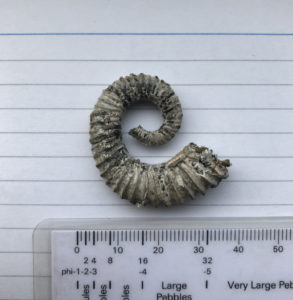
Aegocrioceras. Credits Philip Vixseboxse
Bathrotomaria
A Kimmeridgian (Upper Jurassic) gastropod from Dorset, found on the Rockwatch annual trip. This is preserved as a sandy sediment infill, and was stabilised with Paraloid B72, a type of resin used for conserving fossils. Fossils are common at this locality, but incredibly friable and soft.
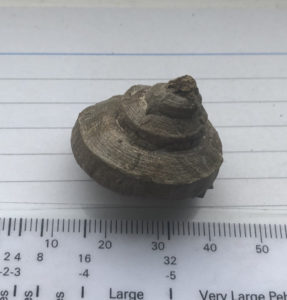
Bathrotomaria. Credits Philip Vixseboxse
Biplicatoria
A brachiopod shell from the Cretaceous “Red Chalk” of Lincolnshire. This specimen was collected in a quarry since flooded. But the formation is also visible in the cliffs of Hunstanton, Norfolk and Speeton, Yorkshire as well as in a few inland outcrops, as a thin unit (maybe 3m thick) at the base of the normal white Chalk.
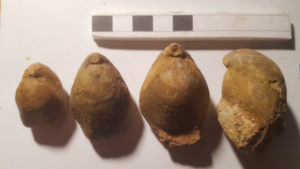
Biplicatoria. Credits Michael Oates.
Dactylioceras
A Toarcian (Lower Jurassic) ammonite from North Yorkshire. This is preserved within a hard limestone nodule, and was split using a geological hammer. Fossils from this locality are abundant, and often preserved in nodules. Other finds from this locality include Harpoceras and Hildoceras ammonites, belemnites, Nuculana bivalves, and fossil wood.
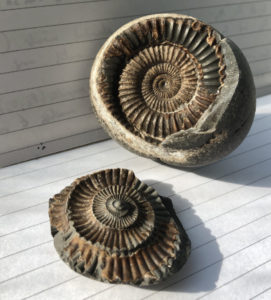
Dactylioceras. Credits Philip Vixseboxse
Neohibolites
These bullet-shaped rods are belemnites – part of the internal skeleton of an extinct squid. They lived throughout the entire Jurassic and Cretaceous period (201-65 million years ago). These small examples (and there are 40 on the same block) are a type called Neohibolites from the Cretaceous “Red Chalk” of Lincolnshire (with a Biplicatoria brachiopod from the same formation). You can pick up identical ones in many places where the Red Chalk or its age-equivalent, the Gault Clay, are at the surface. They are common in many other formations, so expect them in the Jurassic cliffs of Dorset and Yorkshire as well as many other places between.
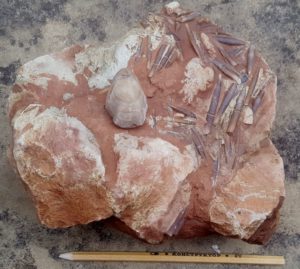
Neohibolites sp. Credits Michael Oates.
Pictoneritina
A 1.5×1.5” specimen box full of the Oligocene gastropod Pictoneritina, from the Isle of Wight. These fossils retain their original colour markings, and were extracted from a loose block of clay using a sieve and water. Many other gastropod and bivalve shells were also recovered in the process.
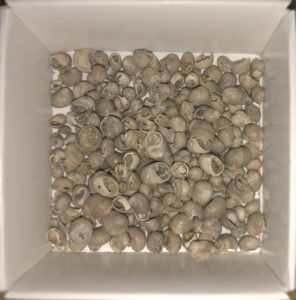
Pictoneritina. Credits Philip Vixseboxse
Titanites titan
Ammonites could grow to immense sizes. In the Portland Limestone, which stretches in an intermittent outcrop from the Isle of Portland to Aylesbury, these giants are fairly common if you can obtain permission to look in a site where it is being dug. They were often used in wall construction during the 19th century as decorative curiosities too. The Portland Limestone is of latest Jurassic age.
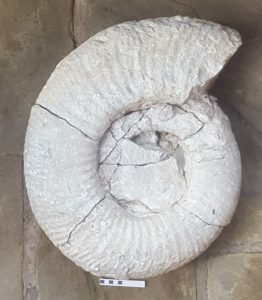
Titanites titan. Credits Michael Oates.
Tylocidaris
Sea urchins come in many shapes and sizes. One of the more bizarre is Tylocidaris which lived on the Chalk sea floor in the Late Cretaceous. They are rarely found complete in chalk exposures, but casts of parts of their shell are rather common in flints picked up in southern England. They also had massive club-like spines, which can be found preserved in the same way, Some plasticine, pressed into the mould, will give a clearer impression of their appearance in life.
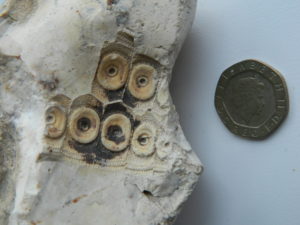
Tylocidaris. Credits Michael Oates.
